
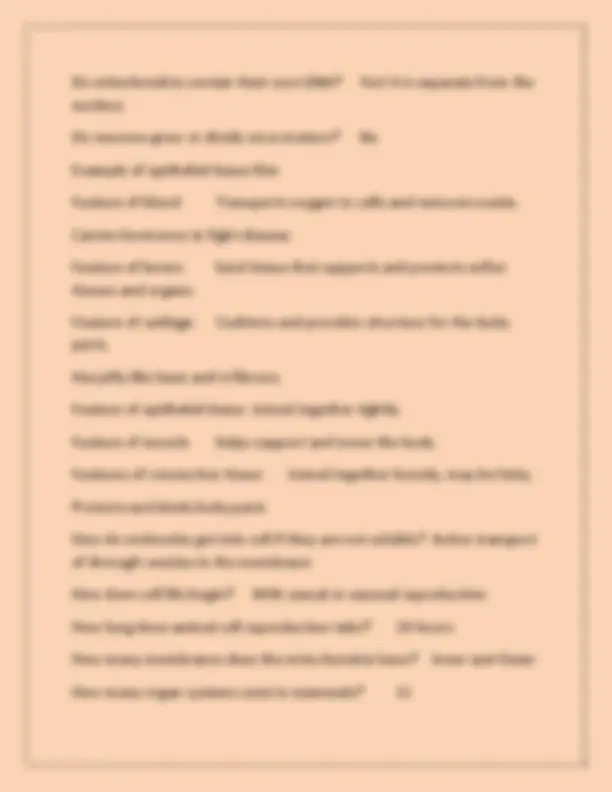
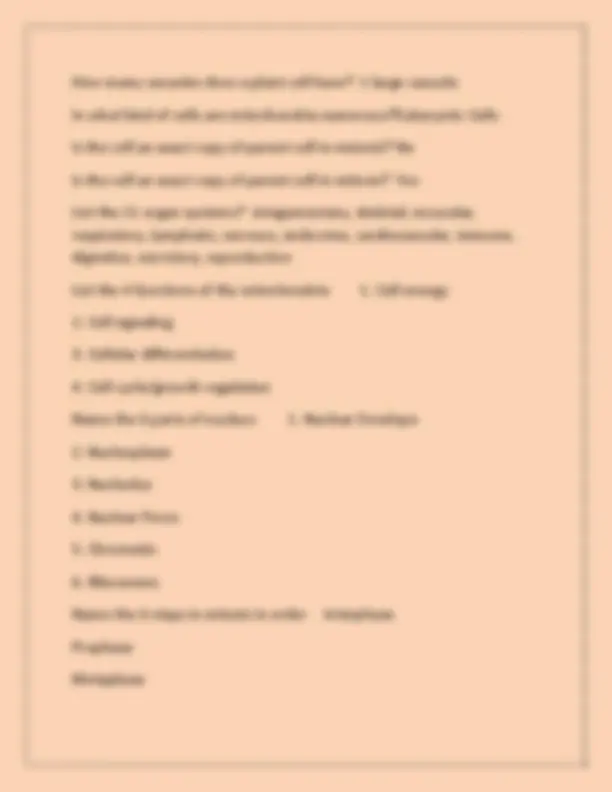
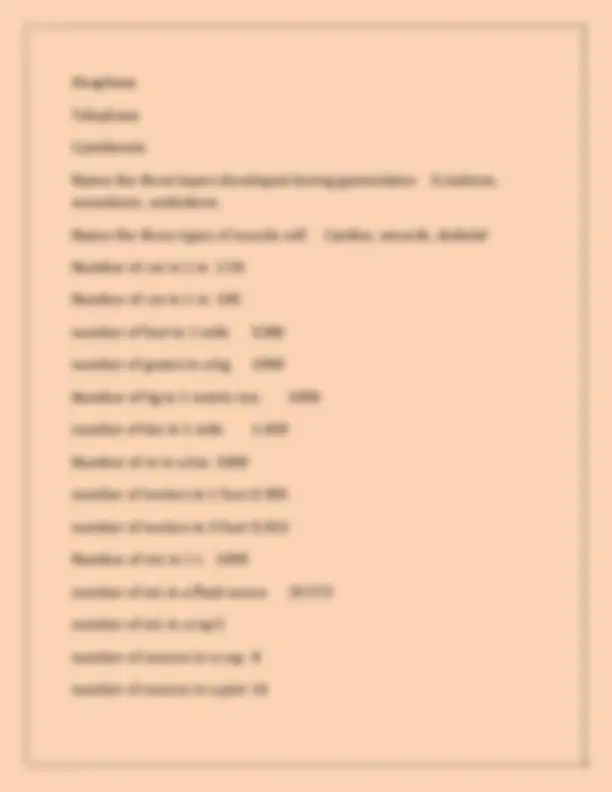
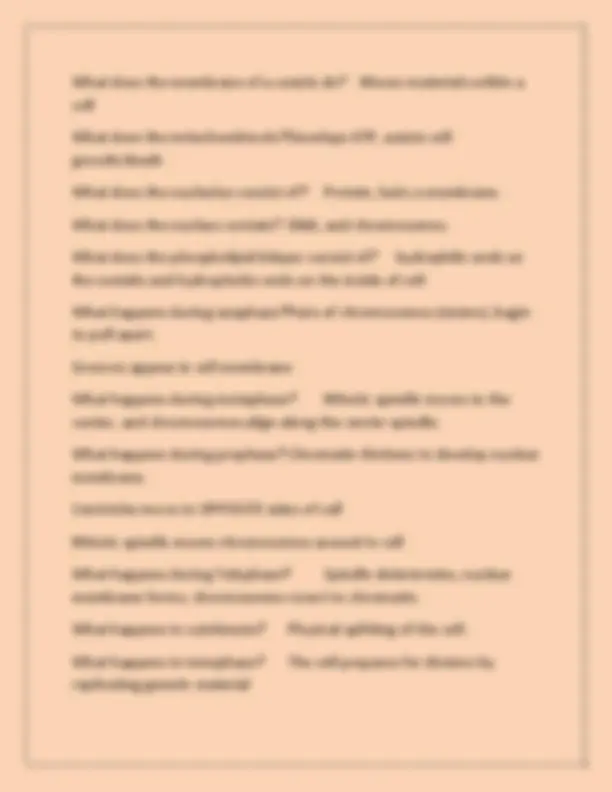
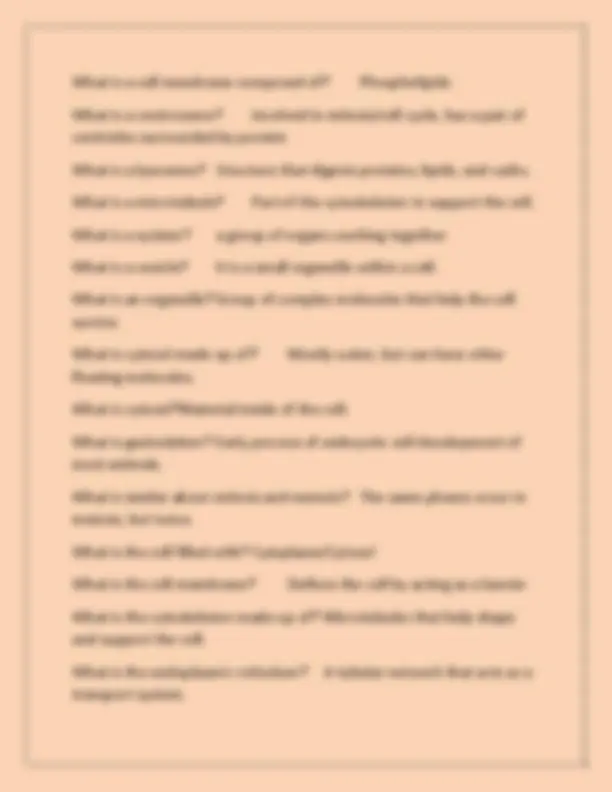
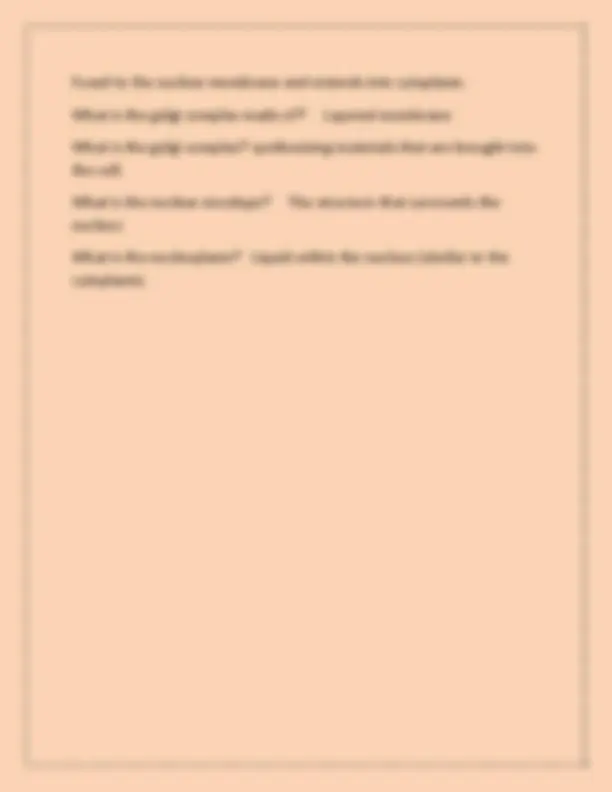


Study with the several resources on Docsity

Earn points by helping other students or get them with a premium plan


Prepare for your exams
Study with the several resources on Docsity

Earn points to download
Earn points by helping other students or get them with a premium plan
Community
Ask the community for help and clear up your study doubts
Discover the best universities in your country according to Docsity users
Free resources
Download our free guides on studying techniques, anxiety management strategies, and thesis advice from Docsity tutors
TEAS 2025|125 Exam Prep review Questions With Complete Answers
Typology: Exams
1 / 10

This page cannot be seen from the preview
Don't miss anything!







What is the nucleus responsible for? Passing genetic material between generations. What is the one thing that cells have in common? Membrane What is the result of the second stage of meiosis? Haploid forms (four daughter cells with different sets of chromosomes) What is the role of the nuclear pores? Exchange material between nucleus and cytoplasm What is the role of the nucleolus? Synthesize Protein, stores RNA, synthesizes RNA What kind of cell controls differentiation? Zygotes What kind of molecule can usually pass through cell membrane Molecules that are soluble in phospholipids What kind of respiration occurs in the mitochondria? Aerobic What makes up organs? Collection of tissues What makes up tissue? collection of cells What molecules typically pass through cell membrane? Oxygen and Water When does meiosis happen? In reproductive cells called gametes Where can ribosomes be embedded? Endoplasmic reticulum
Where does the digestive system develop from? endoderm Where does the muscular system develop from? mesoderm Where does the nervous system develop from? Ectoderm Where is nervous tissue located? brain, spinal cord, nerves Where is the golgi complex located? Near the nucleus. Where is the nucleolus found? Inside of the nucleus `What is the respiratory system divided into? Upper and lower sections Can animal cells have more than one vacuole? Yes Define caudad Closer to the tail or posterior Define cephalad/cephalic Towards the head Define coronal/frontal plane Divides. body into front and back sections Define distal further from the center (the knee is distal to the hip) Define proximal Closer to the center of the body (the hip is proximal to the knee) Define saggital divides body into right and left sections Define transverse Divides body into upper and lower halves Difference between flagella and cilia Flagella are longer, and cells usually only have one Do all eukaryotic cells have a nucleus? Yes
How many vacuoles does a plant cell have? 1 large vacuole In what kind of cells are mitochondria numerous? Eukaryotic Cells Is the cell an exact copy of parent cell in meiosis? No Is the cell an exact copy of parent cell in mitosis? Yes List the 11 organ systems? integumentary, skeletal, muscular, respiratory, lymphatic, nervous, endocrine, cardiovascular, immune, digestive, excretory, reproductive List the 4 functions of the mitochondria 1. Cell energy
Anaphase Telophase Cytokinesis Name the three layers developed during gastrulation Ectoderm, mesoderm, endoderm. Name the three types of muscle cell Cardiac, smooth, skeletal Number of cm in 1 in 2. Number of cm in 1 m 100 number of feet in 1 mile 5280 number of grams in a kg 1000 Number of kg in 1 metric ton 1000 number of km in 1 mile 1. Number of m in a km 1000 number of meters in 1 foot 0. number of meters in 3 feet 0. Number of mL in 1 L 1000 number of mL in a fluid ounce 29. number of mL in a tsp 5 number of ounces in a cup 8 number of ounces in a pint 16
What do chromosomes store? Genetic information about the plant or animal What do glycolipids do? help the cell to recognize other cells of the organisms What do neurons control> responses to changes in external and internal stimuli What do ribosomes do? Synthesize proteins from amino acids What does bone marrow produce? red blood cells. What does each cell consist of? Nucleic acids, cytoplasm, and cell membrane What does each cylinder centriole have? Nine groups of three microtubules. What does meiosis encourage? Genetic diversity What does rough endoplasmic reticulum have? Ribosomes on the outside What does the cell membrane consist of phospholipid bilayer What does the cell membrane do? Helps keep the cytoplasm inside and foreign substances outside. What does the Chromatic consist of? The DNA and protein that make up chromosomes What does the inner membrane of mitochondria do? encloses the matrix (that has mitochondrial DNA and ribosomes)
What does the membrane of a vesicle do? Moves materials within a cell What does the mitochondria do? Develops ATP, assists cell growth/death What does the nucleolus consist of? Protein, lacks a membrane. What does the nucleus contain? DNA, and chromosomes. What does the phospholipid bilayer consist of? hydrophilic ends on the outside and hydrophobic ends on the inside of cell What happens during anaphase? Pairs of chromosomes (sisters), begin to pull apart. Grooves appear in cell membrane What happens during metaphase? Mitotic spindle moves to the center, and chromosomes align along the center spindle. What happens during prophase? Chromatin thickens to develop nuclear membrane. Centrioles move to OPPOSITE sides of cell Mitotic spindle moves chromosomes around in cell What happens during Telophase? Spindle deteriorates, nuclear membrane forms, chromosomes revert to chromatin. What happens in cytokinesis? Physical splitting of the cell. What happens in interphase? The cell prepares for division by replicating genetic material
Fused to the nuclear membrane and extends into cytoplasm. What is the golgi complex made of? Layered membrane What is the golgi complex? synthesizing materials that are brought into the cell. What is the nuclear envelope? The structure that surrounds the nucleus What is the nucleoplasm? Liquid within the nucleus (similar to the cytoplasm).